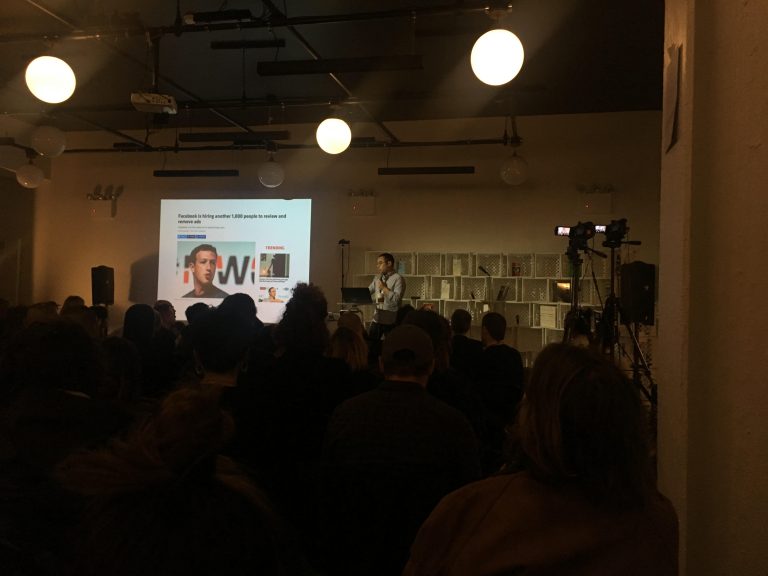
In November 2017, a first-time, independent conference on cybernetics took place at Prime Produce, a new nonprofit cultural event space in midtown Manhattan. Organized by Sam Hart, Melanie Hoff, and Francis Tseng, the conference was a single day to consider how “informatic systems shape social organization.” With the growth of machine learning, big data, and the influence of social media on human thought, the conference seemed like it might be a place to get some timely answers.
The conference began with an introduction to cybernetics by Paul Pangaro, a professor of interaction design, and Michael Yap, his former student. Pangaro emphasized key ideas in cybernetics: systems, feedback, and control. He considered the birth of cybernetics to be in that recognition that “a system can have a purpose.” This is an abstraction from the notion that all living and non-living, self-sustaining systems deal with their environment through mechanisms of response. He gave the example of a thermostat: a temperature is set and the system alters itself toward that temperature. Pangaro went on to explain the more complex models of cybernetics but focused on the abstraction as the core principal, the unifying idea between design, technology, science, art, and so much more.
Pangaro’s introduction was largely about cybernetic thinking as a tool, but most of the following talks were concerned with contemporary societal problems surrounding communication and computation. These included concerns about feedback loops in social spaces, the concentration of power at sites of data collection and organization, and the very notion of how truth is produced. There were also talks with more levity, about Nam June Paik’s art, library systems, and computer-generated poetry. On site, the organizers had arranged for a physical cybernetics library, filled with hundreds of books related to the cybernetics, art, and theory.
The most exciting talks were those that managed to place cybernetics within the broad history of human communication and social organization. Paul Soulellis, a publisher, artist, and designer gave a talk, “Performing the Feed,” which set the idea of online and social media communication into historical context. He stated that the idea of posting, which dominated early communication paradigms online, was more directly related to early modes of publishing all derived from the public sharing of news, of pasting a piece of paper on a literal wooden post. He contrasted this with the new idea of “the feed,” described most obviously in live video streams. While “the post” was the very definition of interruption, of constructing a message that would distinguish itself as a signal separated from the noise, “the feed” works more like a texture, collapsing signal and noise. Soulellis ended his talk by asking, “How can we discern in this new flow?” This idea harkens back to subliminal messaging in the early days of advertising, as if in “the feed,” all content is subliminal.

This conference took place nearly 6 months prior to Mark Zuckerburg’s Congressional testimony, but the journalist Adrian Chen gave a compelling talk surrounding his own work on the Internet Research Agency, the troll farm deeply related to the Russian Election interference narrative, another instance of the collapse of the signal and the noise. Chen recounted his experiences interviewing an employee of the troll farm, and the fallout from this action (all well accounted for in his article for the New York Times, “The Agency”). As a result, he became the point person for understanding “Russian meddling.” What was most compelling about his talk was his statement that he wished he had emphasized the ineffectiveness of the Internet Research Agency. Chen was caught between showing that the anti-Russia concerns were also a form of propaganda, and boosting the pro-Trump contingent.
Truth-making and data were central to almost all the talks.
Mimi Onouha focused on the use of datasets and their inherent bias. Her project “The Library of Missing Datasets” points to even richer concern, that the very sets of data that are chosen are biased, a meta-bias. She gave an example of a project where she collaborated with Broadway actors to get a breakdown of racial representation amongst the stage community, an apparent missing dataset. She further discussed her work, “The Library of Missing Datasets,” which is a filing cabinet filled with empty folders, each labeled with a dataset, like the aforementioned, that have not been constructed. She ends her talk with her concern that the gesture points to a desire to be quantified, that perhaps it is not in more data that these issues will be addressed.

Wendy Chun’s keynote continued the topic of truth-making, bias, and data. Her talk was dense and impressive. Chun introduced a very powerful idea: big data is so “big” because it relies on correlation rather than causality, and as a result the future and the past are structurally the same in predictive models using big data. She explained this idea through a comparison between the racially biased data used in predictive policing to the climate models that reconstruct past data regarding earth’s temperature, pointing to the various statistical techniques used in both. Her talk further explored Cambridge Analytica, Facebook, and the use of the culture of authenticity as a means of highly-refined data collection. We predict the future using these machine learning systems, as a way to change the present, whether that is in policing, C02 emissions, or voting. Chun says that we should ask ourselves what circumstances right now are allowing these predictive models to create plausible futures and how can we construct implausible futures that question the assumptions of plausibility. Her talk was amazing, and worth watching several times.
The Cybernetics Conference engaged the most pressing topics in social media, big data, and politics, and managed to stay focused while dealing with such a vast topic like cybernetics.
(1) Cybernetics Library. Image from Prime Produce.
(2) Adrian Chen’s Lecture “Troll Farming for Good.” Image from Shobun Baile.
(3) Wendy Chun’s Lecture “Proxy Politics as Social Cybernetics.” Image from Internet Society Livestream.




